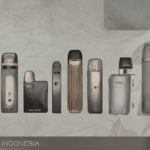-
Table of Contents
The Rise of Vaping in Indonesia

Over the past decade, the use of electronic cigarettes, commonly known as vape, has gained significant popularity in Indonesia. Vaping has become a trend among the younger generation, with vape shops popping up in every corner of major cities. This article explores the evolution of vape devices in Indonesia, from traditional mods to modern pods, and the factors contributing to their widespread adoption.
The Emergence of Vape Mods
Vape mods were the first generation of electronic cigarettes to hit the Indonesian market. These devices were larger and more powerful than traditional cigarettes, offering users the ability to customize their vaping experience. Vape mods allowed users to adjust the wattage, temperature, and airflow, providing a more personalized and satisfying vape. The popularity of vape mods grew rapidly, attracting enthusiasts who enjoyed the technical aspects of vaping and the ability to produce large clouds of vapor.
However, the use of vape mods also raised concerns among health professionals and regulators. The high wattage and sub-ohm coils used in these devices could lead to the production of harmful chemicals and toxins. Additionally, the large clouds of vapor produced by vape mods often caused public nuisance and raised questions about the safety of second-hand vapor. These concerns prompted the development of a new generation of vape devices – the pod systems.
The Rise of Pod Systems
Pod systems, also known as pod mods, emerged as a response to the limitations and concerns associated with vape mods. These devices are smaller, more compact, and easier to use compared to their predecessors. Pod systems utilize pre-filled or refillable pods that contain e-liquid, eliminating the need for users to handle messy bottles of e-juice. The simplicity and convenience of pod systems made them an instant hit among both experienced vapers and beginners.
One of the key advantages of pod systems is their lower power output. Unlike vape mods, pod systems operate at lower wattages, reducing the risk of producing harmful chemicals and toxins. This makes pod systems a safer alternative for those concerned about the potential health risks associated with vaping. Additionally, the smaller size and discreet vapor production of pod systems make them more socially acceptable, addressing the concerns raised by the public about second-hand vapor.
The Role of Nicotine Salts
Another significant development in the evolution of vape devices in Indonesia is the introduction of nicotine salts. Nicotine salts are a form of nicotine that is extracted from tobacco leaves and combined with benzoic acid. This combination allows for a smoother and more satisfying nicotine hit, even at higher concentrations. Nicotine salts have revolutionized the vaping industry, providing users with a more efficient nicotine delivery system.
The use of nicotine salts in pod systems has further contributed to their popularity. The higher nicotine concentrations available in nicotine salts make pod systems more appealing to smokers looking to quit traditional cigarettes. The quick and efficient nicotine delivery provided by pod systems satisfies cravings more effectively, making the transition from smoking to vaping easier for many individuals.
The Future of Vaping in Indonesia
The evolution of vape devices in Indonesia has been driven by a combination of technological advancements, consumer preferences, and regulatory considerations. While vape mods initially dominated the market, the rise of pod systems has revolutionized the vaping industry. The smaller size, lower power output, and convenience of pod systems have made them the go-to choice for many vapers.
Looking ahead, it is likely that pod systems will continue to dominate the Indonesian vaping market. The ongoing development of new pod devices, such as those with adjustable airflow and temperature control, will further enhance the vaping experience. Additionally, the introduction of new flavors and e-liquid formulations will continue to attract users and keep them engaged in the vaping community.
However, it is important to note that the vaping industry in Indonesia is not without challenges. The government has implemented regulations to control the sale and distribution of vape products, including age restrictions and packaging requirements. These regulations aim to protect public health and prevent underage vaping. It is crucial for the industry to work closely with regulators to ensure responsible marketing and distribution practices.
Conclusion
The evolution of vape devices in Indonesia from traditional mods to modern pods has transformed the vaping landscape. The rise of pod systems has addressed the concerns raised by health professionals and regulators, offering a safer and more socially acceptable alternative to traditional cigarettes. The introduction of nicotine salts has further enhanced the vaping experience, making it easier for smokers to transition to vaping.
As the vaping industry continues to evolve, it is important for manufacturers, retailers, and regulators to work together to ensure the responsible and sustainable growth of the market. By prioritizing consumer safety, providing accurate information, and adhering to regulations, the vaping industry in Indonesia can thrive while minimizing potential risks.





